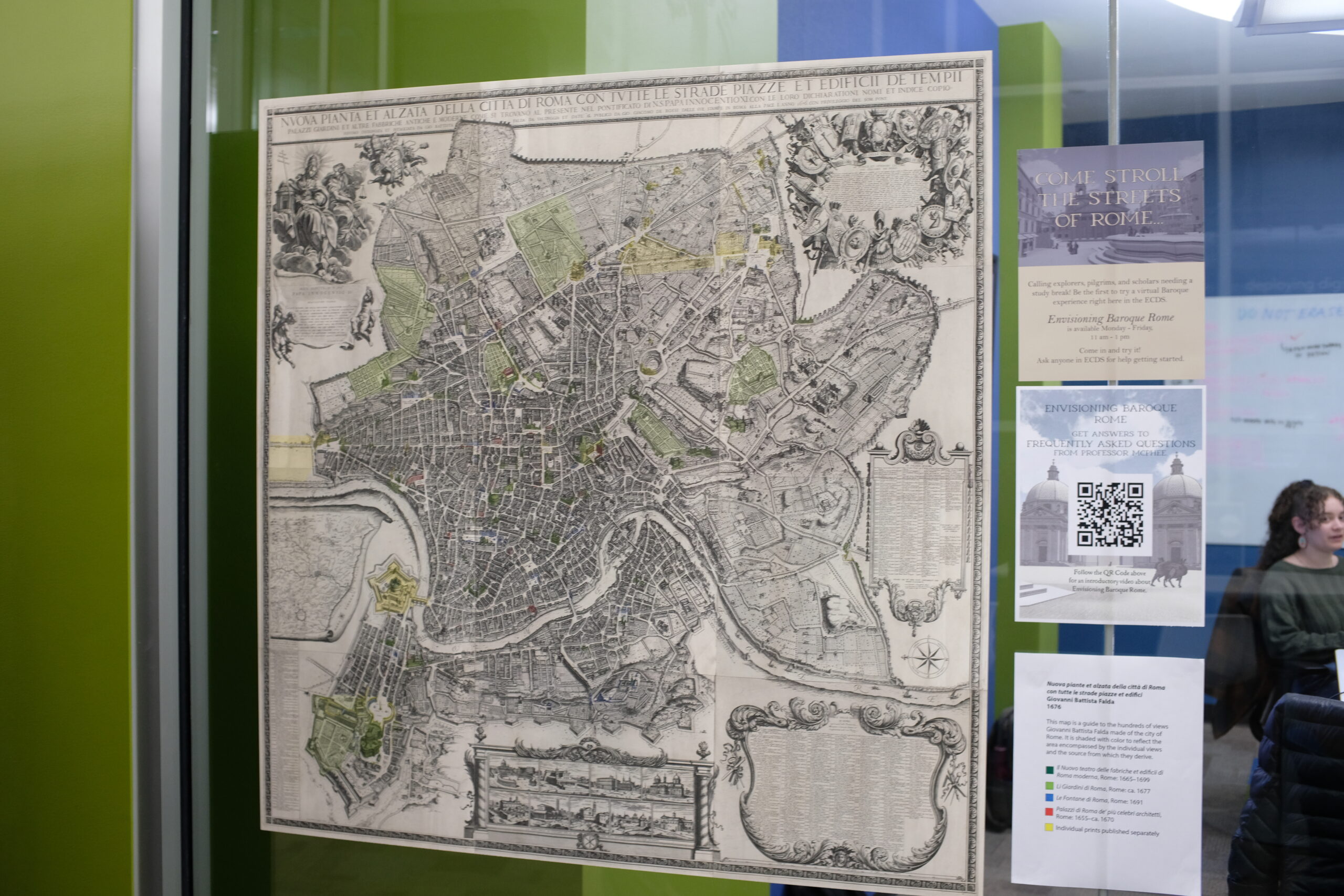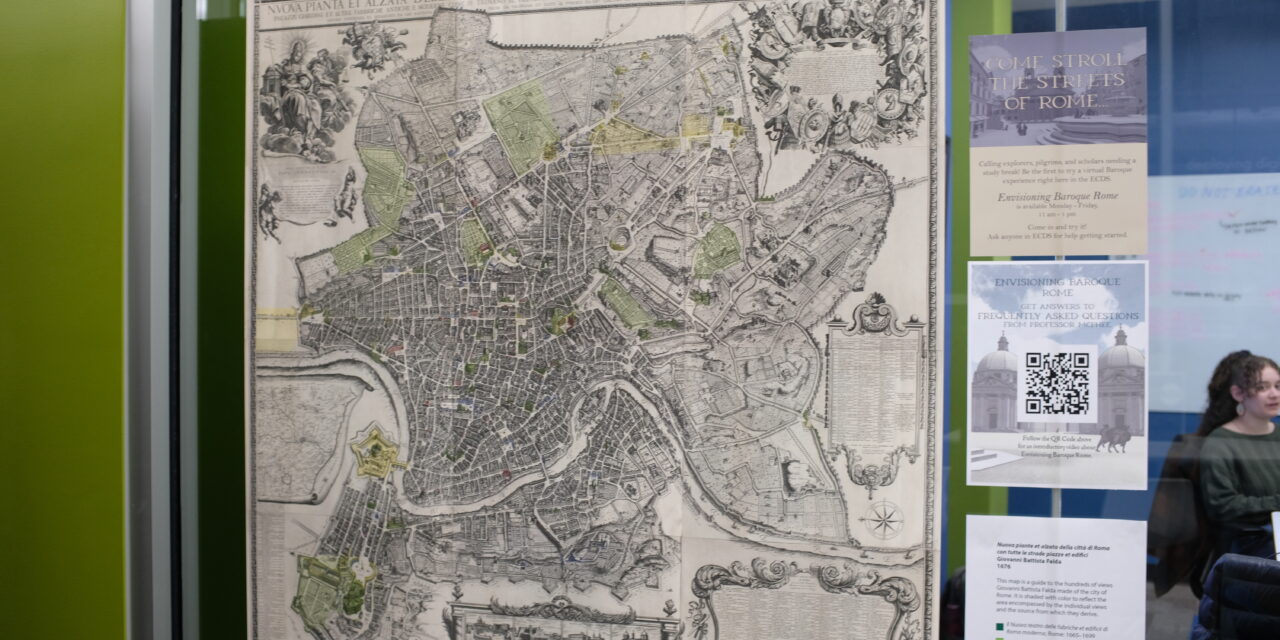
(Alya Khoury/Contributing Writer)
What if you could walk through history and not just read about it? Picture yourself navigating the labyrinth-like alleys of 17th-century Rome, soaking in its architectural wonders and uncovering its hidden secrets. That dream becomes a reality in the Emory Center for Digital Scholarship.
A team of five art historians and digital artists are turning architect and engraver Giovanni Battista Falda’s 1676 map of Rome into an interactive 3D model. This digital project, “Envisioning Baroque Rome,” allows the Emory University community to wander throughout Rome and view the 17th-century landscape through the eyes of Falda by navigating three screens with a gaming controller. As well as being accessible online, their work is on display between 11 a.m. to 1 p.m. in the Emory Center for Digital Scholarship, which is located on the third floor of the Robert W. Woodruff Library.
Samuel Candler Dobbs Professor of Art History Sarah McPhee began this project in 2013, but it gained momentum in 2016. McPhee’s profound appreciation for Italian architecture arose during her sophomore year of college when a professor inspired her to embark on her academic journey.
“I loved architectural history, in particular, because it keeps you honest in the sense that architecture is an expensive art,” McPhee said. “There are economics concerns, there are political concerns, there are materials concerns. You have to understand the whole world that makes a work of architecture to really get it.”
While McPhee has spent countless hours in Italian archival libraries to become an expert on Italian architecture, one specific map inspired her — Falda’s depiction of Rome in 1676.
“I wanted to enter the world of this map that I had been navigating throughout my entire career,” McPhee said.
McPhee believes Falda’s map is, without a doubt, the “finest map of Rome ” produced in the 17th century. She explained that this was the first time that Rome was represented in its modern state, as many engravers previously focused on the Roman ruins.
Ian Burr (15Ox, 17C) serves as the team’s visual design specialist and 3D artist. He combines the research information and creates digital versions. Burr also said that the project being in black and white was a “conscious choice.”
“Falda is essentially our greatest source from this area or most complete source from this area of history,” Burr said. “So it’s to kind of pay homage to the fact that this is, ‘Yes, it’s a historical representation,’ but it is also an in-depth reimagining and recreation of this one artist’s work.”
To bring Falda’s map to life, Burr and the team’s other 3D designer, Nicole Costello Matthews, craft each detail by hand on the digital designer systems, Autodesk 3ds Max and Autodesk Maya, before exporting it into the gaming software Unity. This allows the 2D map to become a 3D world through the screen.
Visual information specialist John Halbert noted that many buildings depicted in the map have been completely lost over time. He explained that the project’s purpose was to highlight how intentional Baroque Italian architecture was.
“There’s various buildings throughout here that have been bulldozed for a highway,” Halbert said.
By working in such proximity to the cartographic archives of this historic city, these digital architects create personal relationships with the past builders of Rome and discover the secrets that hide within the city map, according to Burr.
“In the process of reconstructing a building, you can often kind of figure out what challenges they ran into while they were making it,” Burr said.
Additionally, the team has further uncovered the archeological layers on which Rome was built. Burr said that the Romans in every era had “a mind for preservation” because they were not interfering with ancient materials.
As this project grows and develops, the impact is far reaching. This spatial-temporal travel can be applied across many different disciplines. According to McPhee, Rome has much to teach present-day students and builders.
“Rome as a city, despite its age — maybe because of its age — because of the years of history and the various things that it represents in its urban fabric, is a great model for urban planners,” McPhee said.
Beyond the world of architecture, McPhee also discussed the possibility of collaborating with the Emory School of Medicine to use this project as “therapy.” The project could provide a form of palliative care by helping to distract patients and relieve intense pain, McPhee explained.
The digital nature of the project also allows for global access, ensuring that people from anywhere can dive into Falda’s world. However, above all, McPhee said, this project is meant for anyone who is curious to enter history and appreciate the past rendition of the quintessential city of Rome.
The team of five is filled with an intoxicating passion and an endless chamber of knowledge about each square inch of this project, which allows the Emory community to experience a pivotal moment of history.
“I fell in love with Baroque Rome because it’s a really interesting, transitional moment in world history where science, for example, is going from alchemy and experimentation and kind of oddball ideas about the working of the world to Galilean empirical observation,” McPhee said. “Architecture and the other arts actually reflect those same transitions.”





